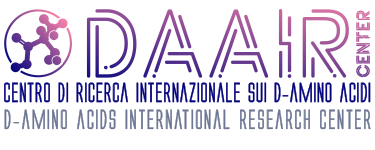Metabolism
D-amino acids (D-AA) are produced by a racemase activity (EC 5.1.1.10) starting from the corresponding L-enantiomer (Pollegioni and Sacchi, 2010; Campanini et al., 2013; Graham et al., 2019). These PLP-containing enzymes catalyse the equilibrium conversion:
| L-amino acid |
———> <——— |
D-amino acid |
In eukaryotes, D-AAs are degraded by the stereoselective flavoenzyme D-amino acid oxidase (DAAO, EC 1.4.3.X), containing one FAD molecule per protein monomer. DAAOs catalyse the O2-dependent oxidative deamination of D-enantiomers of amino acids into α-keto acids, ammonia and hydrogen peroxide:
| D-amino acid + O2 |
———> <——— |
α-keto acid + NH3 + H2O2 |
DAAOs are useful biotechnological biocatalysts (link, link) (Pollegioni and Molla, 2011) as well as targets for the treatment of main human pathologies (link, link) (Sacchi et al., 2013; Molla, 2017).
In bacteria, D-AAs degradation is largely due to D-amino acid dehydrogenases (DAAdH, EC 1.4.99.1). These enzymes, which contains both FAD and nonheme iron as cofactors (Olsiewski et al., 1980), catalyse the same reaction of DAAO on D-AAs without using dioxygen and thus without hydrogen peroxide production. The physiological electron acceptor is coenzyme Q (Jones and Venables, 1983; Campillo-Brocal et al., 2015).
Both DAAO and DAAdH possess a broad substrate specificity and can act on most D-amino acids (Pollegioni et al., 2008; Campillo-Brocal et al., 2015).
References
Campanini B., Spyrakis F., Peracchi A., Mozzarelli A. Serine racemase: a key player in neuron activity and in neuropathologies. Front. Biosci. 2013 1;18:1112-1128.
Campillo-Brocal J., Lucas-Elío P., Sanchez-Amat A. Distribution in different organisms of amino acid oxidases with FAD or a quinone as cofactor and their role as antimicrobial proteins in marine bacteria. Marine Drugs 2015 13(12):7403-7418.
Graham D.L., Beio M.L., Nelson D.L., Berkowitz D.B. Human Serine Racemase: Key Residues/Active Site Motifs and Their Relation to Enzyme Function. Front. Mol. Biosci. 2019 13;6:8.
Jones H., Venables W.A. Effects of solubilisation on some properties of the membrane-bound respiratory enzyme D-amino acid dehydrogenase of Escherichia coli. FEBS Lett. 1983 151(2): 189–192.
Molla G. Competitive inhibitors unveil structure/function relationships in human D-amino acid oxidase. Front. Mol. Biosci. 2017 27;4:80.
Olsiewski P.J., Kaczorowski G.J., Walsh C. Purification and properties of D-amino acid dehydrogenase, an inducible membrane-bound iron-sulfur flavoenzyme from Escherichia coli B. J. Biol. Chem. 1980 255(10): 4487–4494.
Pollegioni L., Molla G., Sacchi S., Rosini E., Verga R., Pilone M.S. Properties and applications of microbial D-amino acid oxidases: current state and perspectives. Appl. Microbiol. Biotechnol. 2008 78(1):1-16.
Pollegioni L., Molla G. New biotech applications from evolved D-amino acid oxidases. Trends Biotechnol. 2011 29(6):276-283.
Pollegioni L., Sacchi S. Metabolism of the neuromodulator D-serine. Cell. Mol. Life Sci. 2010 67(14):2387-2404.
Sacchi S., Rosini E., Pollegioni L., Molla G. D-amino acid oxidase inhibitors as a novel class of drugs for schizophrenia therapy. Curr. Pharm. Des. 2013 19(14):2499-2511.
Author
Loredano Pollegioni, Università degli studi dell’Insubria
